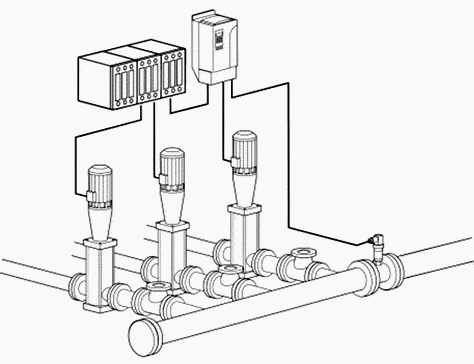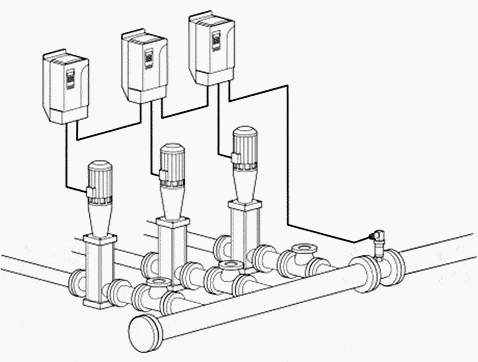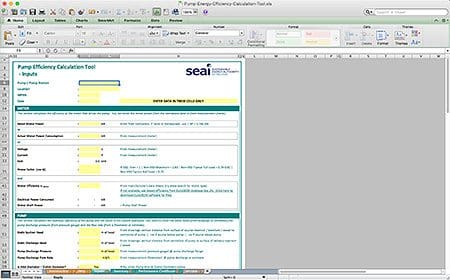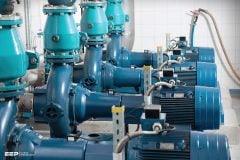Pressure Control Pump Station
Using variable speed drives (VSDs) to control pressure reduces the electrical energy requirements by reducing the amount of hydraulic energy actually produced.

A basic pressure control pump station is equipped with one pump controlled by one variable speed drive (VSD). In some pump stations, pumps connected in parallel are a more efficient solution. Several parallel pumps can be controlled with one VSD controlling the master pump and contactors switching the other pumps on and off.
Figure 1 shows a set-up with parallel pumps using one drive to control three pumps.


System Redundancy
To guarantee pump operation, even when a fault occurs, the pump system needs redundancy. In pump stations this means that a failure of one pump, motor or drive in a parallel installation does not cause a process interruption but the operation will continue with a limited capacity.
In order to have a replacement for a failed unit, a parallel system is needed! This means that each pump is controlled by an industrial drive for pump control.
Drives share information such as status of the drive, priority, running time, process feedback, etc. through a fiber optic link.
In a ring connection implemented with fiber optics it is possible to define the actions for the drives in the event of failure of the optical link in order to achieve 100% redundancy. No PLC is needed.
Figure 2 shows a system loop with three industrial drives in ring connection controlling three pumps.


Might be interesting for you to try free Pump Efficiency Calculation Tool (MS Excel Spreadsheet).


Reference // ABB Application guide No. 2 – Using variable speed drives (VSDs) in pump applications











could you have the same approach for pumps in series ie having a single VSD for 2 pumps?
thanks
Thanks Edvard.
One of the very important uses for VSD’s is irrigation water pumping from bores, deep wells, or surface dams and reservoirs, or simply moving water around through intermediate pumping stations.
Irrigation is nearly always a remote field application and simply characterised by a (1) a power supply (either mains grid or a better option is standalone solar PV); (2) a pump or series of pumps that are controlled by one or more VSD’s; (3) control valves actioned by some sensor controlled logic; and (4) most importantly, robust and fully featured remote communications functionality.
But by the very nature of remote pumping applications, the communications solution implemented should be complimentary to that technology, the key point being remote unattended operations and functionality.
There is no ethernet available in remote field applications – there is no LAN or WAN to tap into for example. System designers of cost effective and unattended remote communications for broad pumping applications should not rely on LAN, WAN or other fixed assets and networked systems availability.
The communications of choice (my company has used for over 20 years for all of our VSD remote and unattended pumping applications) uses the standard mobile/cell service and M2M SIM and a custom “Remote VSD – Monitoring and Control” cell phone APP.
This strategy is a very solid one that provides for full internet access to and control of the VSD system and other control valves and sensors for example on site; in real time 24/7 via a web server IC interfacing with (via a VSD black box) or even integral in the VSD itself. Importantly being standard mobile/cell service via M2M SIM technology; dual redundancy communications are intrinsically available with the service via SMS in the absence of internet service availability or example. Importantly standard (150 character) SMS communications offers exactly the same bisynchronous monitoring and control functionality as internet access can provide using a custom “Remote VSD – Monitoring and Control” cell phone APP.
Lawrence Coomber
I want to know about the general electrical faults in pumps & their troubleshooting tips !! please suggest reference manual .
Thanks!!!
Dear Edvard,
Can you explain your logic how to control 3 pumps with one VSD and 2 contactors. When sistem is started only VSD is on and frequency rises from 20Hz to 50Hz trying to reach SV of the pressure. If SV is not reached, one of slave pumps have to be started with contactor and it start directly at 50Hz. Should frequency of VSD have to be decreased to 20 Hz or to stay at 50Hz. Starting of slave pump will cause hydraulic impact and SV could be exceeded. What is your opinion?
i want to take your knowledge.